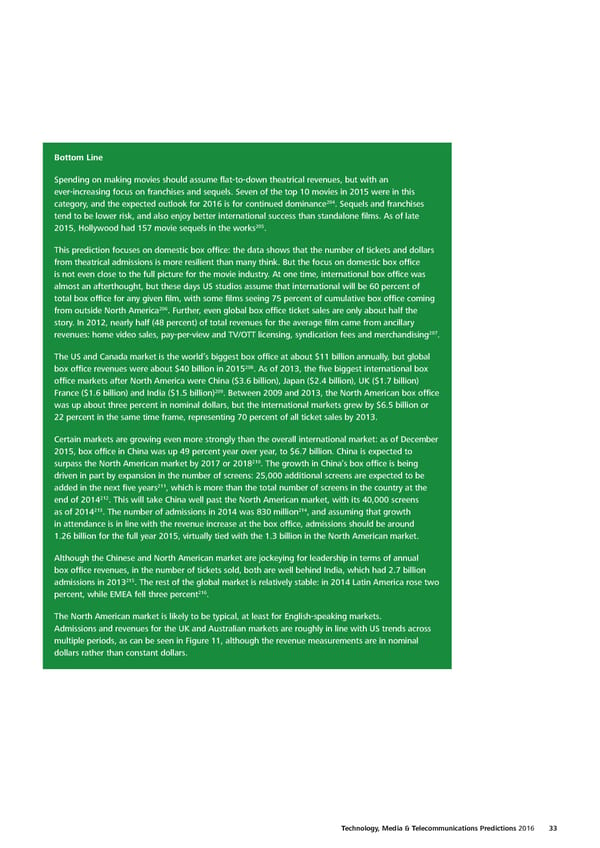Bottom Line Spending on making movies should assume flat-to-down theatrical revenues, but with an ever-increasing focus on franchises and sequels. Seven of the top 10 movies in 2015 were in this 204. Sequels and franchises category, and the expected outlook for 2016 is for continued dominance tend to be lower risk, and also enjoy better international success than standalone films. As of late 205. 2015, Hollywood had 157 movie sequels in the works This prediction focuses on domestic box office: the data shows that the number of tickets and dollars from theatrical admissions is more resilient than many think. But the focus on domestic box office is not even close to the full picture for the movie industry. At one time, international box office was almost an afterthought, but these days US studios assume that international will be 60 percent of total box office for any given film, with some films seeing 75 percent of cumulative box office coming from outside North America206. Further, even global box office ticket sales are only about half the story. In 2012, nearly half (48 percent) of total revenues for the average film came from ancillary 207 revenues: home video sales, pay-per-view and TV/OTT licensing, syndication fees and merchandising . The US and Canada market is the world’s biggest box office at about $11 billion annually, but global 208 box office revenues were about $40 billion in 2015 . As of 2013, the five biggest international box office markets after North America were China ($3.6 billion), Japan ($2.4 billion), UK ($1.7 billion) 209 France ($1.6 billion) and India ($1.5 billion) . Between 2009 and 2013, the North American box office was up about three percent in nominal dollars, but the international markets grew by $6.5 billion or 22 percent in the same time frame, representing 70 percent of all ticket sales by 2013. Certain markets are growing even more strongly than the overall international market: as of December 2015, box office in China was up 49 percent year over year, to $6.7 billion. China is expected to 210. The growth in China’s box office is being surpass the North American market by 2017 or 2018 driven in part by expansion in the number of screens: 25,000 additional screens are expected to be added in the next five years211, which is more than the total number of screens in the country at the end of 2014212. This will take China well past the North American market, with its 40,000 screens 213 214 as of 2014 . The number of admissions in 2014 was 830 million , and assuming that growth in attendance is in line with the revenue increase at the box office, admissions should be around 1.26 billion for the full year 2015, virtually tied with the 1.3 billion in the North American market. Although the Chinese and North American market are jockeying for leadership in terms of annual box office revenues, in the number of tickets sold, both are well behind India, which had 2.7 billion 215. The rest of the global market is relatively stable: in 2014 Latin America rose two admissions in 2013 216. percent, while EMEA fell three percent The North American market is likely to be typical, at least for English-speaking markets. Admissions and revenues for the UK and Australian markets are roughly in line with US trends across multiple periods, as can be seen in Figure 11, although the revenue measurements are in nominal dollars rather than constant dollars. Technology, Media & Telecommunications Predictions 2016 33
 Technology, Media & Telecommunications Predictions Page 39 Page 41
Technology, Media & Telecommunications Predictions Page 39 Page 41